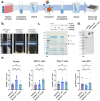This is a preprint.
In vivo targeted gene delivery using Adenovirus-antibody molecular glue conjugates
- PMID: 39974927
- PMCID: PMC11838440
- DOI: 10.1101/2025.01.31.635969
In vivo targeted gene delivery using Adenovirus-antibody molecular glue conjugates
Update in
-
In-vivo-targeted gene delivery using adenovirus-antibody site-specific covalent conjugates.Mol Ther Methods Clin Dev. 2025 May 26;33(2):101497. doi: 10.1016/j.omtm.2025.101497. eCollection 2025 Jun 12. Mol Ther Methods Clin Dev. 2025. PMID: 40525123 Free PMC article.
Abstract
Safe and efficient nucleic acid delivery to targeted cell populations remains a significant unmet need in the fields of cell and gene therapy. Towards this end, we pursued Adenoviral vectors genetically modified with the "DogTag" molecular glue peptide, which forms a spontaneous covalent bond with its partner protein, "DogCatcher". Genetic fusion of DogCatcher to single-domain or single-chain antibodies allowed covalent tethering of the antibody at defined locales on the vector capsid. This modification allowed simple, effective and exclusive targeting of the vector to cells bound by the linked antibody. This dramatically enhanced gene transfer into primary B and T cells in vitro and in vivo in mice. These studies form the basis of a novel method for targeting Adenovirus that is functional in stringent in vivo contexts and can be combined with additional well characterized Adenovirus modifications towards applications in cell engineering, gene therapy, vaccines, oncolytics, and others.
Keywords: DogCatcher; DogTag; Gene delivery; SpyCatcher; SpyTag; adenovirus; molecular glue.
Conflict of interest statement
Declaration of interests: Hongjie Guo is the founder and Chief Scientific Officer of Tiger Biologics, LLC, a protein production company. Paul J. Rice-Boucher. David T. Curiel, and Zhi Hong Lu are co-inventors on a patent application describing the use of the Ad-Ab system for B cell targeting and engineering.
Figures




Similar articles
-
In-vivo-targeted gene delivery using adenovirus-antibody site-specific covalent conjugates.Mol Ther Methods Clin Dev. 2025 May 26;33(2):101497. doi: 10.1016/j.omtm.2025.101497. eCollection 2025 Jun 12. Mol Ther Methods Clin Dev. 2025. PMID: 40525123 Free PMC article.
-
Immunogenicity and seroefficacy of pneumococcal conjugate vaccines: a systematic review and network meta-analysis.Health Technol Assess. 2024 Jul;28(34):1-109. doi: 10.3310/YWHA3079. Health Technol Assess. 2024. PMID: 39046101 Free PMC article.
-
Systemic pharmacological treatments for chronic plaque psoriasis: a network meta-analysis.Cochrane Database Syst Rev. 2021 Apr 19;4(4):CD011535. doi: 10.1002/14651858.CD011535.pub4. Cochrane Database Syst Rev. 2021. Update in: Cochrane Database Syst Rev. 2022 May 23;5:CD011535. doi: 10.1002/14651858.CD011535.pub5. PMID: 33871055 Free PMC article. Updated.
-
Signs and symptoms to determine if a patient presenting in primary care or hospital outpatient settings has COVID-19.Cochrane Database Syst Rev. 2022 May 20;5(5):CD013665. doi: 10.1002/14651858.CD013665.pub3. Cochrane Database Syst Rev. 2022. PMID: 35593186 Free PMC article.
-
Grommets (ventilation tubes) for hearing loss associated with otitis media with effusion in children.Cochrane Database Syst Rev. 2005 Jan 25;(1):CD001801. doi: 10.1002/14651858.CD001801.pub2. Cochrane Database Syst Rev. 2005. Update in: Cochrane Database Syst Rev. 2010 Oct 06;(10):CD001801. doi: 10.1002/14651858.CD001801.pub3. PMID: 15674886 Updated.
References
-
- Lostalé-Seijo I. & Montenegro J. Synthetic materials at the forefront of gene delivery. Nature Reviews Chemistry 2, 258–277 (2018). 10.1038/s41570-018-0039-1 - DOI
Publication types
Grants and funding
LinkOut - more resources
Full Text Sources
